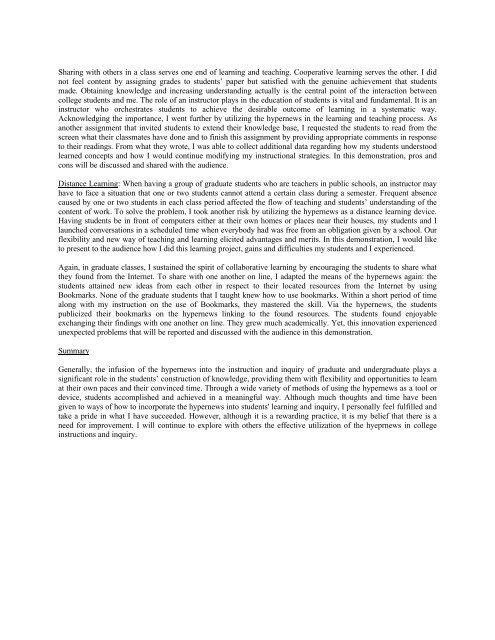ED-MEDIA 1999 Proceedings Book - Association for the ...
ED-MEDIA 1999 Proceedings Book - Association for the ...
ED-MEDIA 1999 Proceedings Book - Association for the ...
You also want an ePaper? Increase the reach of your titles
YUMPU automatically turns print PDFs into web optimized ePapers that Google loves.
Sharing with o<strong>the</strong>rs in a class serves one end of learning and teaching. Cooperative learning serves <strong>the</strong> o<strong>the</strong>r. I did<br />
not feel content by assigning grades to students’ paper but satisfied with <strong>the</strong> genuine achievement that students<br />
made. Obtaining knowledge and increasing understanding actually is <strong>the</strong> central point of <strong>the</strong> interaction between<br />
college students and me. The role of an instructor plays in <strong>the</strong> education of students is vital and fundamental. It is an<br />
instructor who orchestrates students to achieve <strong>the</strong> desirable outcome of learning in a systematic way.<br />
Acknowledging <strong>the</strong> importance, I went fur<strong>the</strong>r by utilizing <strong>the</strong> hypernews in <strong>the</strong> learning and teaching process. As<br />
ano<strong>the</strong>r assignment that invited students to extend <strong>the</strong>ir knowledge base, I requested <strong>the</strong> students to read from <strong>the</strong><br />
screen what <strong>the</strong>ir classmates have done and to finish this assignment by providing appropriate comments in response<br />
to <strong>the</strong>ir readings. From what <strong>the</strong>y wrote, I was able to collect additional data regarding how my students understood<br />
learned concepts and how I would continue modifying my instructional strategies. In this demonstration, pros and<br />
cons will be discussed and shared with <strong>the</strong> audience.<br />
Distance Learning: When having a group of graduate students who are teachers in public schools, an instructor may<br />
have to face a situation that one or two students cannot attend a certain class during a semester. Frequent absence<br />
caused by one or two students in each class period affected <strong>the</strong> flow of teaching and students’ understanding of <strong>the</strong><br />
content of work. To solve <strong>the</strong> problem, I took ano<strong>the</strong>r risk by utilizing <strong>the</strong> hypernews as a distance learning device.<br />
Having students be in front of computers ei<strong>the</strong>r at <strong>the</strong>ir own homes or places near <strong>the</strong>ir houses, my students and I<br />
launched conversations in a scheduled time when everybody had was free from an obligation given by a school. Our<br />
flexibility and new way of teaching and learning elicited advantages and merits. In this demonstration, I would like<br />
to present to <strong>the</strong> audience how I did this learning project, gains and difficulties my students and I experienced.<br />
Again, in graduate classes, I sustained <strong>the</strong> spirit of collaborative learning by encouraging <strong>the</strong> students to share what<br />
<strong>the</strong>y found from <strong>the</strong> Internet. To share with one ano<strong>the</strong>r on line, I adapted <strong>the</strong> means of <strong>the</strong> hypernews again: <strong>the</strong><br />
students attained new ideas from each o<strong>the</strong>r in respect to <strong>the</strong>ir located resources from <strong>the</strong> Internet by using<br />
<strong>Book</strong>marks. None of <strong>the</strong> graduate students that I taught knew how to use bookmarks. Within a short period of time<br />
along with my instruction on <strong>the</strong> use of <strong>Book</strong>marks, <strong>the</strong>y mastered <strong>the</strong> skill. Via <strong>the</strong> hypernews, <strong>the</strong> students<br />
publicized <strong>the</strong>ir bookmarks on <strong>the</strong> hypernews linking to <strong>the</strong> found resources. The students found enjoyable<br />
exchanging <strong>the</strong>ir findings with one ano<strong>the</strong>r on line. They grew much academically. Yet, this innovation experienced<br />
unexpected problems that will be reported and discussed with <strong>the</strong> audience in this demonstration.<br />
Summary<br />
Generally, <strong>the</strong> infusion of <strong>the</strong> hypernews into <strong>the</strong> instruction and inquiry of graduate and undergraduate plays a<br />
significant role in <strong>the</strong> students’ construction of knowledge, providing <strong>the</strong>m with flexibility and opportunities to learn<br />
at <strong>the</strong>ir own paces and <strong>the</strong>ir convinced time. Through a wide variety of methods of using <strong>the</strong> hypernews as a tool or<br />
device, students accomplished and achieved in a meaningful way. Although much thoughts and time have been<br />
given to ways of how to incorporate <strong>the</strong> hypernews into students' learning and inquiry, I personally feel fulfilled and<br />
take a pride in what I have succeeded. However, although it is a rewarding practice, it is my belief that <strong>the</strong>re is a<br />
need <strong>for</strong> improvement. I will continue to explore with o<strong>the</strong>rs <strong>the</strong> effective utilization of <strong>the</strong> hyeprnews in college<br />
instructions and inquiry.
















